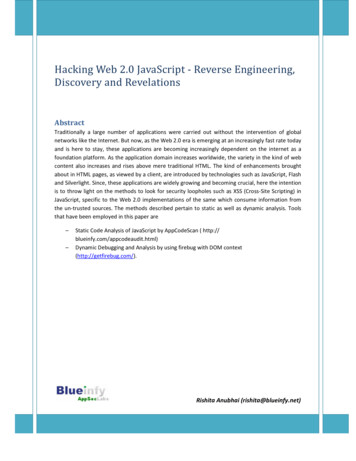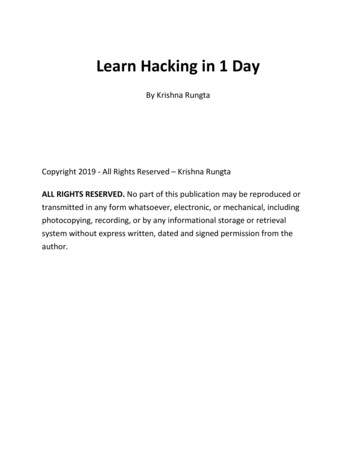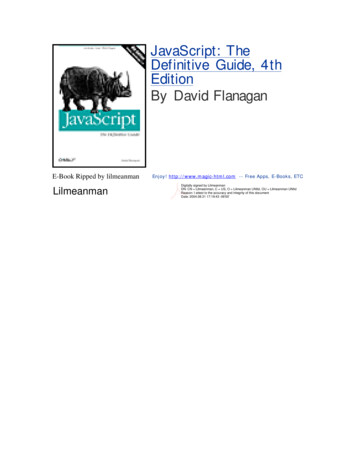
Transcription
Hacking Web 2.0 JavaScript - Reverse Engineering,Discovery and RevelationsAbstractTraditionally a large number of applications were carried out without the intervention of globalnetworks like the Internet. But now, as the Web 2.0 era is emerging at an increasingly fast rate todayand is here to stay, these applications are becoming increasingly dependent on the internet as afoundation platform. As the application domain increases worldwide, the variety in the kind of webcontent also increases and rises above mere traditional HTML. The kind of enhancements broughtabout in HTML pages, as viewed by a client, are introduced by technologies such as JavaScript, Flashand Silverlight. Since, these applications are widely growing and becoming crucial, here the intentionis to throw light on the methods to look for security loopholes such as XSS (Cross-Site Scripting) inJavaScript, specific to the Web 2.0 implementations of the same which consume information fromthe un-trusted sources. The methods described pertain to static as well as dynamic analysis. Toolsthat have been employed in this paper are–Static Code Analysis of JavaScript by AppCodeScan ( http://blueinfy.com/appcodeaudit.html)Dynamic Debugging and Analysis by using firebug with DOM context(http://getfirebug.com/).–Rishita Anubhai (rishita@blueinfy.net)1Abstract Blueinfy Solutions Pvt. Ltd.
Problem DomainJavaScript as we know is a client side technology that uses scripting on the client side to processcertain elements of the HTML page while it is rendered on the browser with DOM context – theclient. In such a case,–All the client side code files are available for the users to inspect and look out for validationloopholes and any other business logic residing.The malicious attackers have a chance to inject client side code snippets in their own favour,since the script tags are permissible in HTML pages with the coming of JavaScript.With reference to the Web 2.0 applications, JavaScript contains a lot of information andbusiness logic in specific. This logic can be reverse engineered by an attacker.Web 2.0 applications are using the Document Object Model (DOM) extensively. As a result, itbecomes easier for an attacker to exploit weakly implemented DOM calls across client sidelogic. For example, eval() on an un-trusted stream.XMLHttpRequests (XHR) Object also makes hidden calls at the back-end. These calls can bediscovered and exploited by any attacker. We have seen popular applications like Twitter orFacebook that were compromised by exploiting XHR calls in this manner.––––Of the many web security attacks that can be used as a result of this, the recent statistics show thefollowing for the distribution with regard to the type of tion-Security-Statistics)Percent of vulnerabilities out of total number of vulnerabilitiesThe criticality of XSSSince the one of the easiest exploitations of JavaScript occurs via the XSS attack it has been taken upas the focus hereafter. It is imperative to observe the trend as well; we are seeing rise of DOM basedXSS in Web 2.0 application context. The synoptic view for the same is as follows:XSS: Cross-Site ScriptingXSS is basically a scenario where the ‘trust on the user, of the hosting webpage is exploited’. Thismeans that client-side code snippets will be injected into the places that the host of the page leastexpects and will be used for maliciously.The three major categories can be summarized as described on the next page but we will focus onDOM based XSS during this particular paper:2Hacking JavaScript Blueinfy Solutions Pvt. Ltd.
TypeReflected(NonPersistent)Fundamental ConceptVulnerabilityAnyuserinputenabled field’s valueis directly reflectedbackintotheresponsepagewithout validation.StoredTheHTMLlinks(Persistent) posted on messageboards, blogs aretailored in a ntly storedon the server of thismessage-boardorblog site.DOMbasedExample ScenarioExploitA script tag thatincludesJavaScriptcode snippet can hencebe injected in this field.Thus, when response isgenerated the codegets executed.Using this category,URLscouldbemalformed to passparameter values withsuch codes and used bythird party attackersfor vulnerable sites andcorrespondinguservictims.The malformed linkbeingpermanentlystored on the server,whenever visited byany user will cause thecode to get executedeach time.No individual targetsare required.Here, the response page is not altered. TheDocument-Object-Model aspects of the pageare accessed and caused to behaveunexpectedly to each user based on the DOMmodifications that have been t.write or eval can be exploited.3Hacking JavaScript Blueinfy Solutions Pvt. Ltd.A field which takes for input, akeyword for searching andgenerates the result page with thestring ‘ keyword-here searchresults:’. Here if along with thekeyword the user also adds:‘ script alert(“xss”); /script ’.Then when the field value isextracted and duplicated on theresponse page, this script alsobecomes a part of the response andgets auto-executed.Consider the following link on apage: a href http://xyz.com/home.htm?name 3; script alert(“hi”); /script ” Thus, whenever clicked, theunaware user visits the pagehome.htm but also causes the codeto be executed which could extractinformation and pass it on to theattackerThe document.location objectcould contain a string such ashttp://xyz.com/home.htm?default script alert(document.cookie); /script .Since this might not expect a codesnippet it will render the entirepage here and the script too isrendered and executed alongside.
Diagrammatic Representation of the ScenarioApproach and ToolsThe approaches to analyse the JavaScript loopholes as aforementioned can be categorized into twodistinct types:Static Code AnalysisIn this approach, we will be downloading all the JavaScript files along with the HTML source code ofthe target page to be audited for such loopholes and analyse it without running it. This meansmeans, thatwithout executionn of the source and interference by supplying runtime data, we shall merelyexamine the call-returnreturn hierarchy of the code and look for loopholes such as slack validation duringXHR Requests and others that will be proposed at a later point.Since the code can be very lengthy to go over it manually the tool that will be used in thedemonstration is the AppCodeScan Tool, a tool put forth by Blueinfy for the purpose of tracking andwalking over functions via calls. This will be used for our purpose here by puttingputting the suspicious startpoint in the ‘Trace’’ field to start with and then analysing the results.The detailed demonstrations will be accompanied by screenshots now for a particular example.example Wedownload the source page for the following page which has widgets.widgets. Seeing the html page thefollowing is notable:4Hacking JavaScript Blueinfy Solutions Pvt. Ltd.
This triggers us to check get rss feed and lbFeedsTherefore we trace the function ‘get rss feed’ & ‘lbFeeds’ in the .js files loaded from the page.Now we know the filerss xml parser.js isour target focused‘get xml file’ new to trace.Thus now we walk for ‘get xml file’. The result in our target focus file gives:5Hacking JavaScript Blueinfy Solutions Pvt. Ltd.
Seeing this, we take up our next target as ‘url’:Proceeding, we focus on the object ‘httpreq’ now:Now the variable ‘xmlfile’ seems interesting to check in this function:In this result that has come out, our interesting target seems ‘processRSS’:We move further to trace ‘response’ now:There we are! Without any validation on the requested url and data, the response has beenobtained. This could be risky, which is demonstrated by the following screenshots in the sequence ofthe events (next page):6Hacking JavaScript Blueinfy Solutions Pvt. Ltd.
When you hover over,the status bar shows:JavaScript:alert(“xss”)Code for anything else could havebeen hence injectedOn clickDynamic Code DebuggingAs far as this approach goes, the looking up of entire code will be avoided. Instead we will be on thelookout for areas in the rendered page which are popular for such vulnerabilities or lookincriminating anyway. Hereafter we will try the XSS injection and analyse the working of the internalcodes by inspecting them via a JavaScript debugger.7Hacking JavaScript Blueinfy Solutions Pvt. Ltd.
The tool that would be convenient to use for this purpose as a debugger for JavaScript code wouldbe a Firefox extension called Firebug (http://getfirebug.com/).In this, we can identify the area on the page then use the extension’s capacity to map the area to thecorresponding HTML block and thereafter set a breakpoint on the function being called. Once that isdone, working on the page will be followed up in the Firebug panel on the side by correspondinglyhighlighted function call-returns. By setting successive breakpoints in this manner and analysing theXHR requests being made and the validation used if any, along with runtime data supplying to HTMLelements such as forms, a dynamic analysis of the page with respect to XSS security can be done.Once again, the detailed demonstration of a sample case will be accompanied by screenshots for aparticular case in the Dynamic Approach Detailing below.In the firebug panel shown, we input the function-name: ‘get rss feed’ and the ‘Script’ area in theleft frame will get us to the function header. On clicking the area marked ‘Click here’ we can add abreakpoint there.Add the phrase to searchhere: ‘get rss feed’Click here: Adds a breakpointNow, as and when we click on the actual page anywhere the function is traced into by using the‘play, step into, step over’ functions in the right hand top corner of the left frame in the firebugpanel.Now as we select ‘Trade News’ from the dropdown list shown on the page (‘Trade News’ is wherethe XSS exploit has been planted), as we saw in the HTML code earlier due to the event ‘onchange’the function get rss feed is called and our breakpoint is encountered. Now on pressing ‘Step into’the trace begins. The screenshot shown below is that when on the first pressing of ‘Step Into’ theline 54 is highlighted to show current line of operation.8Hacking JavaScript Blueinfy Solutions Pvt. Ltd.
We follow the trace to line 56 and then the call to get xml file is made and shown as follows in thetrace:On tracing further we reach the following stage where line 31 is the operative line:Now the page is loaded with the ‘Trade News’ widget too. Now on tracing the click on the‘Interesting News Item’ the following appears:And there we are once again! Starting from choosing the item to here, we have not validated againstsuch code snippets and therefore, this will be executed in the same manner as shown in the finalresult in the ‘Static Code Analysis Section’.9Hacking JavaScript Blueinfy Solutions Pvt. Ltd.
ConclusionMethodologies and approach described in this paper can help in discovering vulnerabilities inJavaScript driven Web 2.0 applications. The popular lookout areas apart from DOM based XSS are:––––––––––Password comparisons in .jsBusiness Logic Leaks in the client side: example: priceEvals() used without appropriate validationsAll XHR requests without filters for ‘script’, ‘JavaScript’ tags and commandsInjections by Unicode or escape sequencesDirect reflection of the input from user formsCookies not limited or localised to IPs and thus permitted cookie leakagesServer side filters to avoid stored XSSUnescaped usage of or can permit tags more easily tooEmails unescaped could increase the spamming disadvantages10Hacking JavaScript Blueinfy Solutions Pvt. Ltd.
since the script tags are permissible in HTML pages with the coming of JavaScript. - With reference to the Web 2.0 applications, JavaScript contains a lot of information and business logic in specific. This logic can be reverse engineered by an attacker. - Web 2.0 applications are using the Document Object Model (DOM) extensively.










